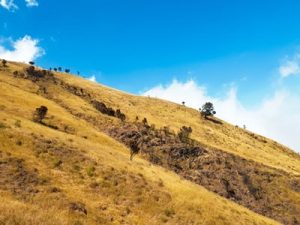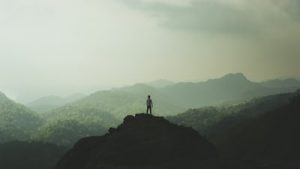CHANGING OUR HUMAN-CENTRIC POINT OF VIEW
We live in a vast universe, part of a complex fabric of many forms of life, yet our species behaves as if we are separate from that weave.
To understand our place as members of the larger community, we have to widen the viewfinder from our myopic human-centric focus to the bigger picture. This allows other perspectives to come into play, and new possibilities. It also enables us to act as participants instead of problems in the great life endeavor.
RELATIONAL FIELD
A relational field is a landscape—metaphysical or real—where the position of the point of view determines relationships to other elements, and to the larger context. A shift in placement changes the appearance of the terrain and impacts relationality. Any relational field links to a pattern of wholeness. In reconnecting with the big picture, we can find where we belong, where the fullest expression of the individual parts leads to the flourishing of the entirety. Working with the relational field offers a means to restore balance, and to allow for the resources around us—of intelligence, energy, possibility and potential—to participate in guiding us in a new pattern of relationship with the rest of the community of life.
Let’s picture our current dominant paradigm as a square room, a box. The walls and the floor are the foundational values of this worldview. It’s all we can see. If we are in the room long enough, it’s easy to believe that’s all there is.
If you are looking to me, standing on my soapbox, for answers or insight, a duality has already been established, a hierarchy perhaps. So I invite you: let’s undo that— let’s open up the box. Imagine the walls dissolve. Imagine we—all the occupants of this square, closed room—now find ourselves instead in a field. It’s not a flat field at all, but rises rather steeply to a summit behind us, glowing in the late afternoon sun. We’re in the hollow at the bottom, chilly in shadow, the whole crowd of us bunched together, confined by the topography. What should we do?

Someone would suggest we move up, into the sun, onto the top, and we’d all agree, and make our way to the higher ground. It’s accessible to all. Everyone, no matter their mobility challenges, can come too.
From the top, there’s a great view. We can see that the mound we’re on is surrounded by a river, with slopes rising also on the other side—one is rocky shale; another is forested. Beyond are more peaks and valleys. Now we know where we are. But it’s still crowded on this small summit—not much room to do anything other than stand and look.
At this point, we want to spread out. Some choose to go down into the forested area and build a cabin. Some people choose to go to the riverbank; some to the lowlands of the meadow. All of us but one disperses into the landscape, finding the individual place of preference, each person doing what it is they want to do. As a safety measure, one agrees to stay on the peak as a lookout, a sort of anchor for the community. Periodically we all meet back at the summit to report on what’s been going on and share news. The view from the top holds it all, the wider perspective, which is given substance, fleshed out, as it were, by the experiences on the ground, the individual subjective impressions, the animals and plants people encounter, the kinds of trees and amphibians present, and so forth. These all contribute to the bigger picture we’re forming of this landscape. But though it’s increasingly encompassing, it’s still a human-centric perspective.

Let’s imagine that the human at the top restores that central point of view to the hilltop. People still make the trek to the summit every now and then to convene and share their experiences, but the bear, the fox, the gentian, the salamander, and all the others have equal weight there, too. The absence of a person occupying the top creates space there. Now the hilltop itself, rather than a person, is the anchor, and for a much larger community that now includes us people. After all, the hill is very old. It affects the weather and governs the watershed, and its shape is responsible for all the microclimates. Over the eons, it has accommodated as the river course adjusted round it, as the forest composition matured, as the diversity of animals changed with the shifting parameters, and as, most recently, humans arrived on the scene. Without it, none of us would be there, obviously—where would we even stand?
How does the viewpoint of the hilltop change things? We still live in the same places, all over the landscape—the cabin in the forest, or the lowland meadow—but the assumptions of dominance are no longer there. The shift has adjusted humans and their perspective to size. They are now members of a larger community of life. We now have to think differently about every action. Before we cut down this tree, we have to ask, what does the tree or the hill or the salamander say about that? Humans are part of the landscape rather than occupants.

Now we’ve opened the box. A number of questions arise, of course, such as, how do we communicate with the tree, the hill, the salamander? Non-verbal communication is going on around us all the time—the chemical messages of trees and insects, and the exchanges facilitated by vast underground mycorrhizal networks, for example. Using metaphorical language helps to reorient ourselves in the imaginative landscape. (Through the story we have already experienced a shift in place in the hierarchy of this plane of interaction. Initially, in the crowded shadowy hollow, we humans were cut off by our restricted view from what lay around us. We had no wider vision; just ourselves, in our own faces. We shared no connection with the landscape because of the crowding. The move to the summit gave us some breathing room and outlook that led to us movement and room for increasing diversity of subjectivity in the context of the whole..)
Closed off in our box we had did not have access to the resources we can discover all around us — of intelligence, energy, and new potential. Opening the point of view gives us access to so many possibilities that weren’t evident before, including creating a new pattern of behavior and relationship with the rest of life.
© Chez Liley All Rights Reserved